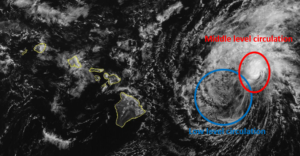Former Hurricane Iona rapidly weakened to a tropical storm over the Central Pacific Ocean southwest of Hawaii on Wednesday. At 5:00 p.m. EDT on Wednesday the center of Tropical Storm Iona was located at latitude 11.7°N and longitude 162.6°W which put the center about 730 miles (1180 km) south-southwest of Honolulu, Hawaii. Iona was moving toward the west at 22 m.p.h. (35 km/h). The maximum sustained wind speed was 65 m.p.h. (105 km/h) and there were wind gusts to 80 m.p.h. (130 km/h). The minimum surface pressure was 994 mb.
Former Hurricane Iona rapidly weakened to a tropical storm southwest of Hawaii on Wednesday. Iona moved into a region of drier air. The drier air caused many of the thunderstorms in Iona’s circulation to dissipate. A few thunderstorms were still occurring in bands in the southern and eastern periphery of Tropical Storm Iona. An upper level trough southwest of Hawaii was producing southwesterly winds that were blowing toward the top of Iona’s circulation. Those winds were causing moderate vertical wind shear. The vertical wind shear was also contributing to the weakening of Tropical Storm Iona.
The circulation around Tropical Storm Iona was small. Winds to tropical storm force extended out 80 miles (130 km) from the center of Iona’s circulation.
Tropical Storm Iona will move through an environment that will be mostly unfavorable for intensification during the next 24 hours. Iona will move over water where the Sea Surface Temperatures are near 27°C. It will move under the southeastern part of the upper level trough southwest of Hawaii. The upper level trough will continue to produce southwesterly winds that will blow toward the top of Iona’s circulation. Those winds will continue to cause moderate vertical wind shear. In addition, Iona will also continue to move through the region of drier air that is located southwest of Hawaii. The combination of moderate vertical wind shear and drier air will cause Tropical Storm Iona to start to continue to weaken during the next 24 hours.
Tropical Storm Iona will move around the southern side of a high pressure system over the Central Pacific Ocean. The high pressure system will steer Iona toward the west during the next 24 hours. On its anticipated track, Hurricane Iona will move farther away from of Hawaii on Thursday.
Elsewhere over the Central Pacific Ocean, the upper level trough southwest of Hawaii caused former Tropical Storm Keli to weaken to a tropical depression. At 5:00 p.m. EDT on Wednesday the center of Tropical Depression Keli was located at latitude 13.9°N and longitude 156.6°W which put the center about 520 miles (835 km) south of Honolulu, Hawaii. Keli was moving toward the west at 17 m.p.h. (28 km/h). The maximum sustained wind speed was 35 m.p.h. (55 km/h) and there were wind gusts to 45 m.p.h. (75 km/h). The minimum surface pressure was 1006 mb.

